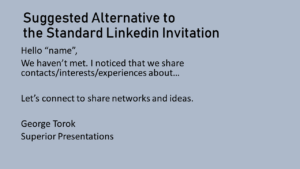First Impressions Still Count – Even On Social Media
What first impressions do you want to convey when you ask a person to connect with you on social media? Have you considered the unintended message you might be sending when you click to send the standard message?
“I’d like to join your Linkedin network.”
You’ve probably received this standard invitation to connect on Linkedin.
Perhaps you’ve sent it. I have, and I’m not proud of doing that. It’s the standard message for connecting on Linkedin.
What could be wrong with sending this message? It’s the standard message. That means that all you did was click and Linkedin does the rest.
What message might that say about you and your intentions?
You invested the least amount of effort. What might the person who receives that message think? You were impersonal, thoughtless and lazy. You’re simply attempting to harvest contacts.
Why would they accept your invitation when it was so impersonal?
The second fault is in the wording of the “invitation” because it’s not an invitation. There’s no benefit to you.
Do you remember when you received a real invitation to a party or event? It described why you would want to participate – invite you to receive a benefit.
This standard message is simply a “gimme something” message.
This is like a beggar asking for money. “Gimme money because I need it.” Linkedin isn’t a place for charity.
The context of this standard message is focused on the sender. “I’d like”. Why would the receiver care what you’d like? What’s in it for them?
What are you offering? Why should I connect with you? That’s the question you want to address if you want to make a positive first impression.
What might you say in your invitation?
The key points are:
- Customize your message – make an effort
- Offer a benefit – something of value that might intrigue the person
First Impressions Still Count – Even On Social Media
©George Torok is The Speech Coach for Executives and creator of Superior Presentations. He coaches executives and trains professionals to deliver Superior Presentations.
Related posts for you
Where can You Listen to Your Intended Message Podcast
Are You a Results Driven Professional?


